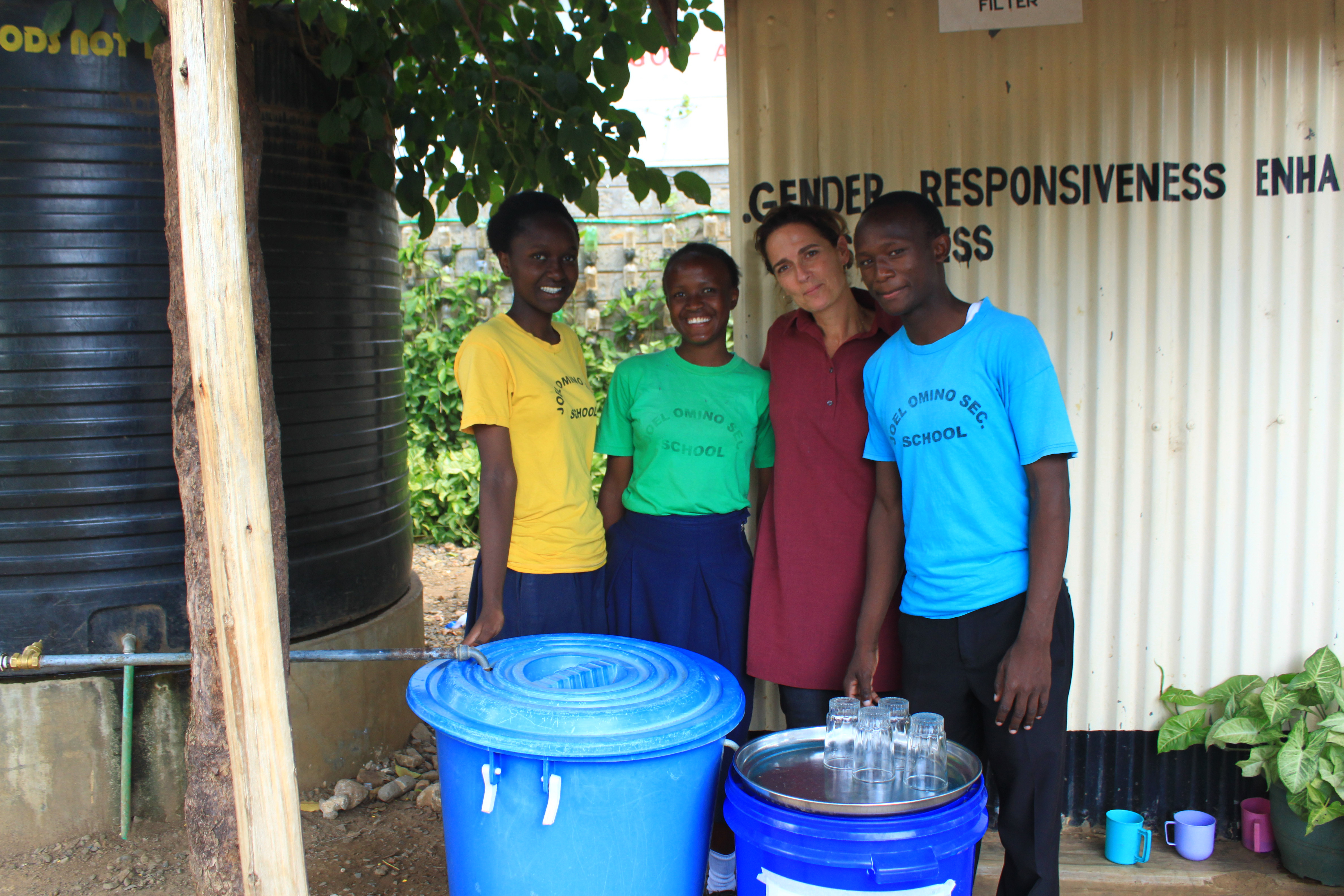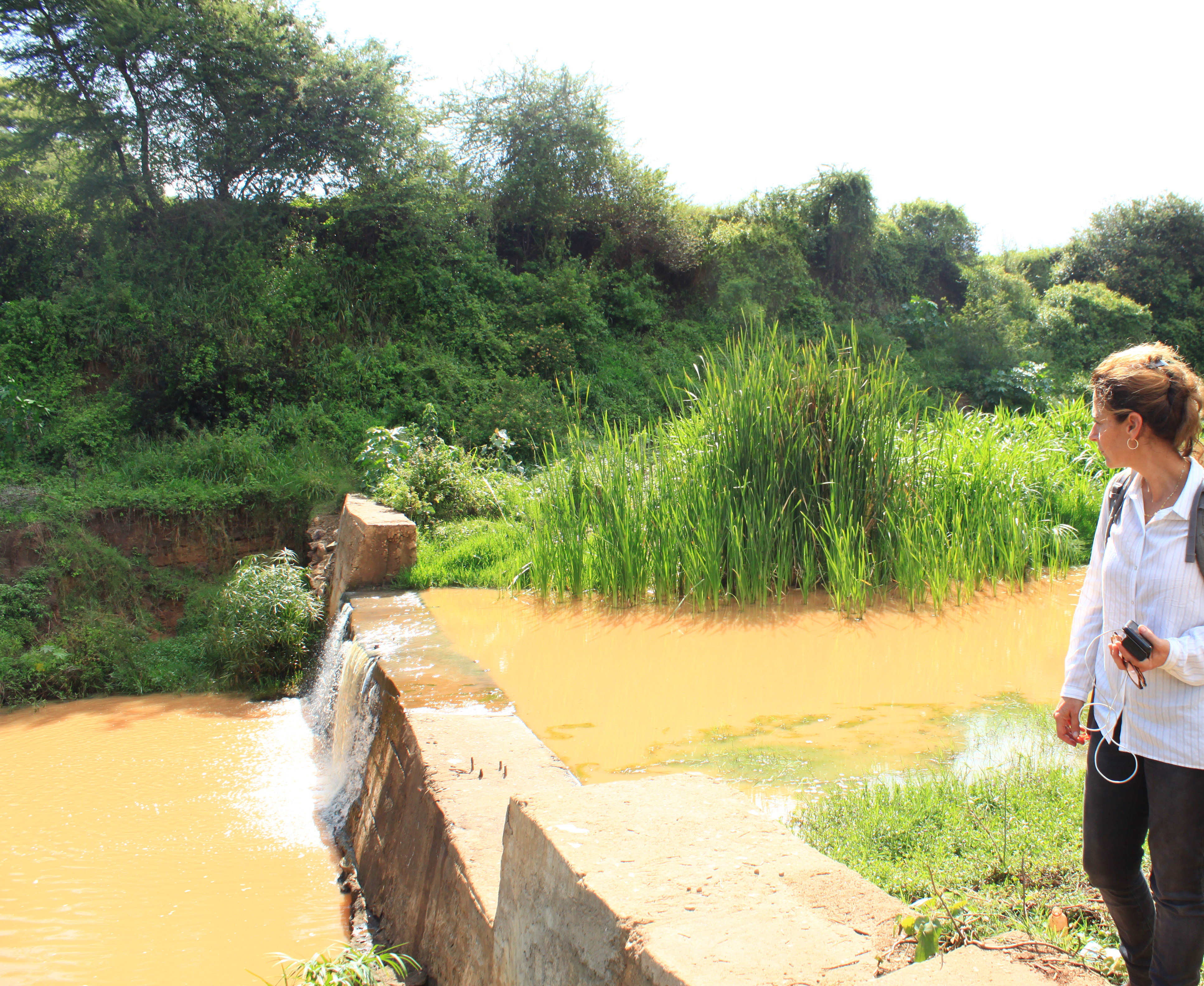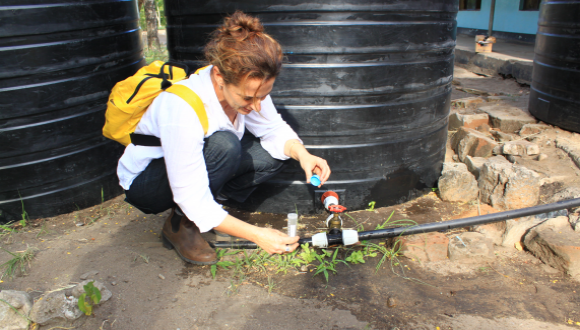MA study at the Department of Environmental Studies examines systems used by local communities in Africa, upgrading natural water for drinking purpose
Michal Dolev Hashimshony, a graduate student at the Department of Environmental Studies, is traveling to Africa to study the effectiveness of appropriate technologies for water treatment and utilization (ATWTU). These systems are operated by local residents in rural areas under water scarcity, to produce clean and safe drinking water
Africa has running water, water in wells and water in large lakes, yet Africa is thirsty for water. More than 300 of the 800 million people living south of the Sahara suffer from a lack of safe drinking water. Many get ill and even die from diseases related to the use of water that is not suitable for drinking (In the image above: Michal is sampling rain-harvested water after treatment).
After learning of the UN guidelines for sustainability (Agenda 2030), Michal Dolev Hashimshony, a graduate student at the Department of Environmental Studies, chose to focus her research on one of the acute problems - Sustainable Development goal No. 6. of drinking water and sanitation. The study examines local systems to Improve the quality of water from Natural sources in African by local communities. The study is conducted under the supervision of Prof. Avital Gasith, Dr. Orly Ronen and Dr. Alex Golberg of the Department of Environmental Studies and Dr. Nurit Hashimshony Yaffe of Tel Aviv-Jaffa Academic College.
The study has two objectives: first, to identify simple, achievable and sustainable local technologies used by local residents to upgrade natural water (rain water, wells, rivers, lakes); the second, examination of water treatment knowledge among local residents in water-thirsty areas..
The common approach of many private and international bodies is to provide developing countries with advanced technologies sometime the state of the art for water treatment. These technologies are more suitable for government agencies that have the means for long-term operation and maintenance of these systems but are less suitable for local villagers. As a result, in many cases advanced technologies fail in the long run as a result of inability to maintain the system and the turn useless. The researchers chose a completely different approach of learning and adopting technologies that represent local knowledge and capacities.
The researchers define this approach as "appropriate technologies for water treatment and utilization" (ATWTU). Appropriate technologies were defined by the economist Ernst Schumacher as required to be adapted to the environmental, economic and knowledge of the local community. The researchers identified several ATWTU technologies and chose to focus in the first phase on four solutions implemented by the communities:
- Sand filtration (BioSand) (Figure 1)
- Sand Dams in Rivers (SanDam) (Picture 2)
- Rainwater harvesting and storage systems, with or without additional treatment (filtration and disinfection) (Fig. 3)
- Char filtration using locally prepared bone-char filter (charred cattle bones). This method was found to be particularly effective in reducing the level of fluoride in water in places where its level in the water is high and may cause health problems (Picture 4).

Image 1 - Michal with students, by a bio-sand filtration system set up in their school by Joel Omino in Kisumu, Kenya
.
Some of the water treatment systems were established as functional and demonstration projects by Education for Sustainable Development (ESD) graduates of MASHAV in Israel, as part of Israel's policy of assisting in the implementation of UN goals. Other systems were introduced as NGO projects aimed at implementing UN Sustainable Development Goal 6, Clean Water and Sanitation, in Africa.
The study examines the effectiveness of the systems in improving water quality in selected locations in Africa. The water quality is assessed by to significant variables: turbidity and bacterial quality. In addition to assessment of the water treatment effectiveness (before and after treatment), interviews are conducted with members of the community to determine the degree of knowledge that they have for a specific technology, their ability to establish their own treatment systems and the existing technical knowledge for maintenance of these systems.
Among the places where Michal traveled she reached Kisumu, on Lake Victoria, Kenya. Although Lake Victoria is one of the largest freshwater lakes in the world, local residents suffer from shortage of potable water.

Image 2 - SAND DAM water filtration system in Mwala, Kenya
A second phase of the research in Africa is a study planned here at Tel-Aviv University. The researchers plan to duplicate at the Department of Environmental Studies (The Porter School of the Environment and Earth Sciences) one of the common system, BioSand filtration. The system will be exposed to extreme water quality conditions and tested for its limit to produce safe drinking water. This knowledge will be shared with partners in Africa. Moreover, options of simple improvement of the filtration system and its operation are also considered.
At early stage the researchers approached the School of Environmental Studies at the University of Kenyatta. After learning of the research, the head of the school expressed their will to cooperate. This will require joint application for research funding which will allow further advancing this research.
Image 3 - Taking a sample from a rainwater harvesting system in the village of Mingjingo, Tanzania
The researchers are assisted by the Israeli Embassy in Nairobi, when needed. In May of this year the study was presented to the ambassador of Kenya to Israel at a meeting held at the Porter Building (TAU). The research was recently presented to 80 graduate students from around the world (including Africa) at a conference organized by MASHAV - an assistance arm of the Israeli Ministry of Foreign Affairs and in cooperation with the Mann Institute for Food Security (TAU).
An article prsenting this study was published last month in the magazine of water professionals "Water and Irrigation", Volume 556, May 2019 (in Hebrew).
The article published in "Water and Irrigation" professional magazine (Hebrew)
Image 4 - Bone Char filter - a filtration system using charred cattle bones, effective among others of removing fluorides, (operating at a school in Tanzania).

Image 5 - Locally produced filtered potable water


